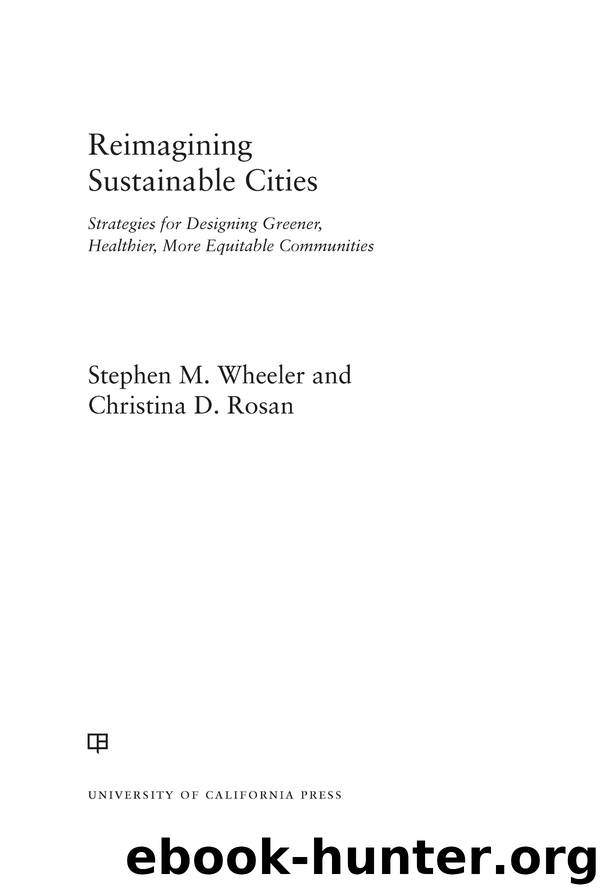Reimagining Sustainable Cities by Stephen M. Wheeler

Author:Stephen M. Wheeler
Language: eng
Format: epub
ISBN: 9780520381216
Publisher: University of California Press
Restore Ecosystems
The move toward ecological restoration has coincided with the deindustrialization of large areas within North American and European cities, meaning that large amounts of brownfield land have become available for reclamation. Early projects included restoration of green spaces within Germanyâs Ruhr Valley as well as riverfront parks within Pittsburghânot coincidentally both former centers of the steel industry.15 Often designers kept remnants of the former mills, factories, and industrial infrastructure as a way of honoring an areaâs history.16 Any abandoned industrial site is now a leading opportunity for urban greening. Cities can actively identify these and initiate planning processes.
Shorelines represent another major opportunity for restoration and recreation. In the late twentieth century, London put walkways along the Thames and built a pedestrian bridge arching over the river to the new Tate Modern museum (itself housed in a reclaimed power plant). The San Francisco Bay Area launched planning for a five-hundred-mile Bay Trail around the entire bay. Toronto developed restoration plans for its two main riparian corridors, the Humber and Don Rivers, and turned an enormous landfill extending into Lake Ontario into Tommy Thompson Park. Such examples show how cities can provide residents renewed connections to local bodies of water.
Landfills represent a third main opportunity area worldwide. Although once on the urban edge, many old dump sites are now near the center of metropolitan areas and thus can provide millions of people with green space. In the 2000s, Cairo converted a five-hundred-year-old waste dump in the middle of its old city into El Azhar Park, which includes social services in addition to green spaces.17 Tainan, Taiwan, used volunteer labor to turn a landfill into Barclay Memorial Park. New York converted its own gargantuan landfill, the worldâs largest, into the 2,200-acre Fresh Kills Park on Staten Island.
Restoration efforts have been informed by landscape ecology and movements for use of native species and involvement of local communities as green space stewards. Such synergies have created a fifth main era of park design according to Galen Cranz and Michael Boland: the ecological or sustainable park.18
Download
This site does not store any files on its server. We only index and link to content provided by other sites. Please contact the content providers to delete copyright contents if any and email us, we'll remove relevant links or contents immediately.
Kathy Andrews Collection by Kathy Andrews(11730)
The remains of the day by Kazuo Ishiguro(8821)
Paper Towns by Green John(5089)
Spare by Prince Harry The Duke of Sussex(5072)
Industrial Automation from Scratch: A hands-on guide to using sensors, actuators, PLCs, HMIs, and SCADA to automate industrial processes by Olushola Akande(4978)
The Body: A Guide for Occupants by Bill Bryson(4974)
Machine Learning at Scale with H2O by Gregory Keys | David Whiting(4178)
Be in a Treehouse by Pete Nelson(3947)
Never by Ken Follett(3790)
Harry Potter and the Goblet Of Fire by J.K. Rowling(3774)
Goodbye Paradise(3727)
Into Thin Air by Jon Krakauer(3312)
The Remains of the Day by Kazuo Ishiguro(3293)
The Cellar by Natasha Preston(3260)
The Genius of Japanese Carpentry by Azby Brown(3224)
Fairy Tale by Stephen King(3220)
120 Days of Sodom by Marquis de Sade(3179)
The Man Who Died Twice by Richard Osman(2997)
Drawing Shortcuts: Developing Quick Drawing Skills Using Today's Technology by Leggitt Jim(2996)
